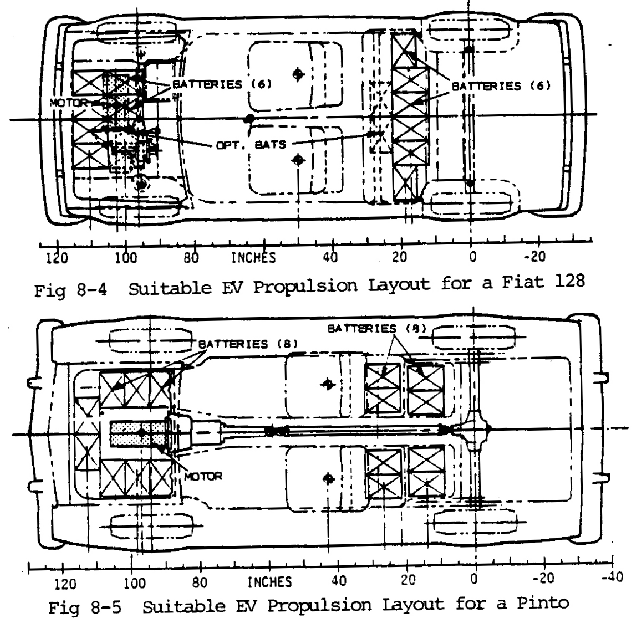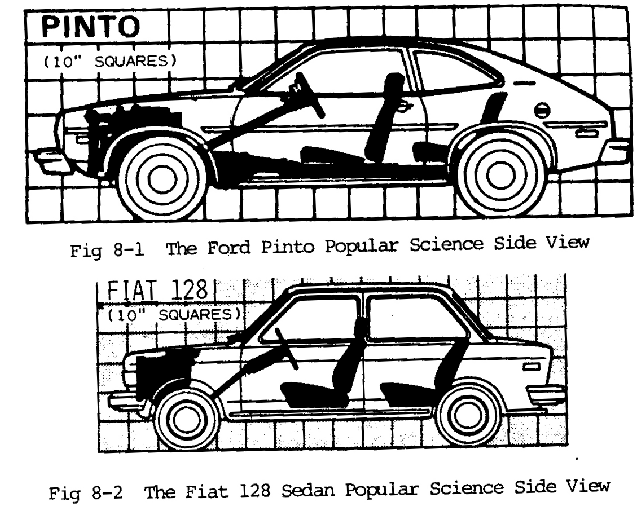
Thanks,
Mike Chancey
Conversion Layouts that Control Weight and F/R Distribution
It is difficult to overemphasize the importance of weight control when converting an automobile powered by a comparatively unlimited energy source (like a tank of gasoline) to one powered by a quite limited source of energy (like a battery pack). As stated in the beginning of this guidebook, the percentage of battery weight in the gross vehicle weight (GVW) is the most important parameter in obtaining good EV performance. With lead-acid batteries, the battery weight fraction should be at least 30% of GVW and greater than that if either high speed or high range is a performance goal. Furthermore, when the GVW of an EV converted from an internal combustion engine (I.C.E.) version is maintained at not much more than the fully loaded weight of the I.C.E. version, the car's suspension, brake, and bumper performance will usually be satisfactory with little or no modification (especially for the lower performance capability of the EV conversion). Keeping the car's longitudinal balance (i.e., the front/rear weight distribution) reasonably close to that of the original I.C.E. version will maintain good steering and handling capability.
The importance of minimizing weight makes it appropriate to reconsider, for EV operations, the desirability of carrying certain accessories and spares that are normal for most I.C.E. cars. Among such is the spare wheel and tire, which even in I.C.E. cars is seldom used. Since most EVs are, by energy limitations, constrained to around-town driving without long trips, the spare wheel and tire might better be left in the garage for its potential use, perhaps once in several years. Tire changing tools are then also better left in the garage; with their weight allowance being more appropriately allotted to EV related equipment (perhaps a few hand tools, a cable or bolt cutter, and a plastic detergent bottle, filled with acid-neutralizing soda water). An air conditioner, if one was provided in the I.C.E. version, should be eliminated, since it is of marginal value for typical EV trip durations and especially because its power requirements approach that needed for the car itself. Rear seats are another option whose retention depends upon the intended car use (needed, of course, for car pooling but rarely of value for short trip, second car operations typical for EVs). A typical EV item that is often "built in" and continually carried is the propulsion battery charger. Since most routine charging is done overnight in the owner's garage, the garage seems an ideal place to leave the charger. In those instances when a return trip recharge is desired, and time for it is available, the portable charger can easily be taken along as an item of cargo rather than being carried routinely when it is not needed.
In the analysis procedures and example worksheets that follow, those weight items that are considered of marginal utility for EVs, as mentioned above, are eliminated from the example EV conversions. This does not mean, of course, that in particular circumstances or intended modes of operating the EV, these items are not logical and desired. The object is to emphasize that unnecessary weight is costly in performance. For every two pounds of unnecessary weight that is carried an additional battery weight approximating one pound is needed to maintain equivalent performance.
MAINTAINING A CONVERSION WEIGHT RECORD
When making a vehicle conversion from one type of propulsion to another, it is almost essential to maintain a running weight record, or log, if one is to avoid several hundred pounds of unacceptable weight (that crept in a few pounds or ounces at a time) by the end of the project. The writer has managed numerous advanced vehicle development projects in aircraft, marine and automotive fields, and always weight has been the most difficult variable to control when building prototypes or one-of-a-kind modifications. Mechanics and Technicians who work on boats and automobiles are notorious for "boiler plating" (i.e., using 1/8" thick angle iron to mount something when bent .050" aluminum or .030" stainless steel would be more than adequate, or using a 5/16" bolt when a No. 8 machine screw is plenty).
Preferably the conversion weight record should include the weight of all items removed as well as the weight of all items added to the vehicle. Still more important, an estimate should be made at the beginning the project for the weight of all items to be added, and these estimates carefully compared with the scale weight of the actual items about to be added. By doing so, in many instances, a change of material, resizing or remounting or even changing to a lighter component n be accomplished at little or no cost and with no loss of component function. Without a running weight record, carefully maintained, such overweight items accumulate one by one with the end result mentioned above. Obviously some scales are needed to weigh the parts. Two quite adequate types are readily available at second-hand household thrift shops in most communities: a 20 or 25 pound capacity household, baby or postage scale and the 250 or 300 pound capacity platform type bathroom scale. Such scales are normally of the simple extension spring and pointer type but are capable of good accuracy if cleaned up so they do not bind during operation and if carefully checked or calibrated for accuracy. (Plain tap water is a universally available calibration medium if accurate means are available for measuring its volume, since plain water weighs 8.34 pounds per gallon when its temperature is near 62 degrees F.)
Weighing the complete vehicle at least one or two times during the conversion process is almost essential. In some localities a drive-on public scale is available but a more useful and convenient procedure is to weigh the car in its partially completed state as the conversion evolves. For this purpose, weighting the car "one wheel at a time" is most convenient. This can be accomplished using two or three bathroom scales at a time, with the one wheel weight being distributed to two scales by a straight beam (say a 1 1/2 ft long 2x6), or to three scales by a triangular spreader (say an equilateral triangle made of I" thick plywood). For this procedure to provide a correct weight equaling the total reaction of the 4 wheels, it is essential that each wheel's height remains a constant distance from the floor (otherwise changing spring deflections will redistribute the weight causing an incorrect total). This means, of course, that the car must first be set on blocks whose heights are equal to that of the combined is deflected to approximately the intended readings, although such platform scales do not have a very great deflection range). While all this may sound a bit troublesome, it will be found an interesting operation and can almost be guaranteed to help in maintaining weight control.
TYPICAL CAR COMPONENT WEIGHTS AND LOCATIONS
For conversion planning information, prior to committing an actual vehicle to the conversion process, there are several magazine sources for automotive weight and balance information. Back issues of Popular Science magazine and automotive magazines such as Road and Track provide data on weights, F/R weight distribution, gear ratios, brake and suspension information, as well as general arrangement drawings. Two such general arrangement drawings (by courtesy of Popular Science magazine) are shown in Figures 8-1 and 8-2, the Ford Pinto and the Fiat 128. These two I.C.E. vehicles are used as EV conversion examples in this and the following section.

|
|
WEIGHT (LB) |
CURB |
WT FOR EV |
| BODY/CHASSIS | |||
| Body, Including Paint & Glass | 824.2 | 32.2 | |
| Bumpers | 140.2 | 5.5 | |
| Grille and Lamps | 13.8 | 0.5 | |
| Exterior Ornamentation | 3.8 | 0.1 | |
| Instrument Panel & Steering Wheel | 28.4 | 1.1 | |
| Interior Trim (less A & B below) | 159.2 | 6.2 | |
| A. Rear Seats & Seat Belts | 28.3 | 1.1 | 28.3 |
| B. Rear Floor & Tunnel Insulation | 6.5 | 0.3 | 6.5 |
| Suspension & Shock Absorbers | 132.5 | 5.2 | |
| Steering System | 58.3 | 2.3 | |
| Wheels (5) | 75.9 | 3.0 | (1/5) 15.2 |
| Tires & Valves (5) | 90.6 | 3.5 | (1/5) 18.1 |
| Radiator | 10.5 | 0.4 | 10.5 |
| Exhaust System | 40.5 | 1.6 | 40.5 |
| Fuel Tank, Lines & System | 26.7 | 1.0 | 26.7 |
| Engine Supports | 14.9 | 0.6 | (~1/2) 7.4 |
| Throttle, Shift, Clutch Control | 6.9 | 0.3 | (~1/2) 3.5 |
| Standard Tools (mostly tire change) | 8.2 | 0.3 | 8.2 |
| Gasoline, Full Capacity | 81 | 3.2 | 81 |
| Body/Chassis Subtotals | (1750.4) | (68.5) | (245.9) |
| PROPULSION & BRAKING | |||
| Engine and Accessories | 390 | 15.3 | 390 |
| Transmission (4 speed manual) | 73 | 2.9 | |
| Drive Shaft | 14 | 0.5 | |
| Drive Axle (Rear, 6 3/4" hypoid) | 105.5 | 4.1 | |
| Brake System | 119.4 | 4.7 | |
| Engine Coolant and Oil | 25 | 1.0 | 25 |
| Transmission & Axle Lubricant | 5 | 0.2 | |
| Propulsion & Braking Subtotals | (731.9) | (28.6) | (415.) |
| ELECTRICAL, HEATING & VENTILATING | |||
| Electric Circuits, ect. | 22.2 | 0.9 | |
| Heater System (hot water type) | 18.0 | 0.7 | 18.0 |
| Battery (Start-Light-Ign. Gp. 24) | 33.5 | 1.3 | 33.5 |
| Elec, Heat & Vent. Subtotals | (73.7) | (2.9) | (51.5) |
| CURB WEIGHT (I.C.E. Propulsion) | 2556 | 100% | |
| REMOVABLE ITEMS (for EV Conversion) | 27.9% | 712 |
Similar weight breakdown information, although not nearly so detailed, has also been published on the Fiat 128 (Ref25). This published Fiat data was based upon a European version; upward adjustments in weight have been made for the heavier bumpers and larger engine and fuel tank required for the American market. The Fiat weight breakdown data are shown in Table 8-2. It will be noticed that both the Pinto and Fiat weight tables have separately listed the weight items considered typically removable for conversion to an EV. This removable weight is seen to approximate 28% of curb weight for the Ford Pinto and 30% of curb for the Fiat 128.
Table 8-2 Weight Breakdown, Mid-70s Fiat 128
|
|
WEIGHT (LB) |
CURB |
WT FOR EV |
| BODY/CHASSIS | |||
| Body (Including trim ect.) | 837 | 44.3 | |
| Bumpers (wt. inc. U.S. standards) | 73 | 3.9 | |
| Suspension | 110 | 5.8 | |
| Steering | 30 | 1.6 | |
| Wheels & Tires (5) | 130 | 6.9 | (1/5) 26 |
| Exhaust | 25 | 1.3 | 25 |
| Fuel Tank, Lines & System | 23 | 1.2 | 23 |
| Standard Tools (mostly tire change) | 8 | 0.4 | 8 |
| Gasoline, Full Capacity | 77 | 4.1 | 77 |
| Body/Chassis Subtotals | (1313) | (69.5) | (200) |
| PROPULSION & BRAKING | |||
| Engine and Accessories | 285 | 15.1 | 285 |
| Transaxle/Transmission | 85 | 4.5 | |
| Drive Axle (front drive) | 39 | 2.1 | |
| Brake System | 57 | 3.0 | |
| Engine Coolant and Oil | 22 | 1.2 | 22 |
| Transaxle Lubrication | 6 | 0.3 | |
| Propulsion & Braking Subtotals | (494) | (26.1) | (307) |
| ELECTRICAL, HEATING & VENTILATING | |||
| Electric Circuits, ect. | 20 | 1.1 | |
| Heater System (hot water type) | 30 | 1.6 | 30 |
| Battery (Start-Light-Ign. Gp. 24) | 33 | 1.7 | 33 |
| Elec, Heat & Vent. Subtotals | (83) | (4.4) | (63) |
| CURB WEIGHT (I.C.E. Propulsion) | 1890 | 100% | |
| REMOVABLE ITEMS (for EV Conversion) | 30.2% | 570 | |
*Items removable from "body" weight:
rear seats & belts, 21 lb; |
|||
For conversion planning purposes prior to actually removing the components from a real vehicle and recording their true weight, reasonable estimates for the weight and balance effect of their removal can be obtained from Table 8-3.
Table 8-3 Typical Factors for Removable I.C.E Components of Compact and Sub-Compact Cars
|
|
WT FACTOR |
|
| I.C.E. Engine and Accessories | 0.15 x CW | Range ~.14 to .18 |
| Fuel Tank, Lines and System | .011 x CW | Or ~ 2 lb/gal cap'y |
| Exhaust System | .014 x CW | Catalytics heavier |
| Radiator | .004 x CW | |
| Hot-Water Heater System | .010 x CW | |
| Starting-Lighting-Ignition Battery | .015 x CW | |
| Spare Wheel and Tire | .014 x CW | |
| Rear Seat and Seat Belts | .011 x CW | |
| Rear Floor Pad and Insulation | .003 x CW | |
| Standard Engine Supports | .005 x CW | |
| Throttle, Shift & Clutch Controls | .003 x CW | |
| Typical Tool Set (mostly tire change) | .004 x CW | |
| I.C.E. Vehicle Fluid Weights | ||
| Gasoline | 6.2 lb/gal | |
| Coolant (glycol-water mix) | 2.1 lb/qt | |
| Engine Oil & Typ. Lubes. | 1.8 lb/gt |
CONVERSION WEIGHT AND BALANCE CALCULATIONS
The front/rear (F/R) weight distribution of a car is, like weight, an important factor in the car's handling performance and in the safety considerations of braking and stability. As mentioned above, for good performance in these respects, it is necessary that the F/R distribution of the EV conversion not be very different from the original I.C.E. version. In general, the changes in F/R distribution that do occur are preferred to be in the direction of 50/50 distribution, rather than adding load to the axle already supporting more than half of the GVW.
For balance purposes, in order to maintain an appropriate front/rear weight distribution, it is necessary to keep track of the fore and aft locations of all components removed from or added to the car, in addition to maintaining a record of the weight of these items. Figure 8-3, for example, shows the location of the propulsion components and other major removable items to be removed from the Fiat 128 prior to adding its EV components. As indicated by the longitudinal scale below the vehicle, the location of these items is measured from the center of the rear axle. Such measurements can be made from a scale drawing of the vehicle, such as this figure, or, of course, by measurements taken from the actual car. It is important, of course, that the measurements be made in a manner that provides a horizontal distance measurement and not an upward or downward sloping distance from the axle itself.
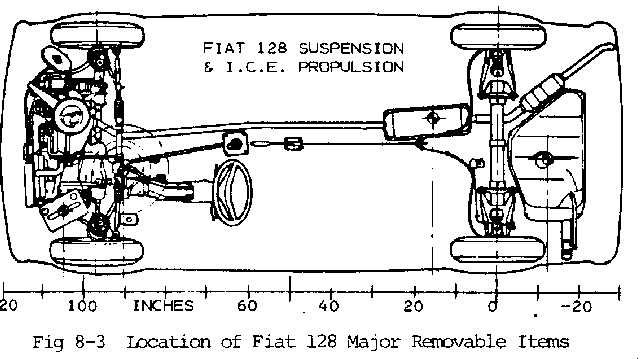
To determine the F/R distribution change. caused by adding or removing a weight item, it is necessary to calculate the item's fore and aft "moment" and add or subtract this moment from the car's total moment. The item's moment is its fore and aft location, or "moment arm," measured from the center of the rear axle in inches, multiplied by the item's weight in pounds. The moment, in other words, is simply the item's weight times its distance from a reference point, which in this instance is the rear axle. The moment arm, or distance from the car's axle, is called the Lcg,. The item's weight times its Lcg is typically, then, a fairly big number which is added to or subtracted from the car's total moment when the item is added or removed from the car. If the item is behind the rear axle the Lcg is negative (so removing such an item adds to the car's moment while an addition of weight here reduces the car's moment).
For- those not already familiar with the procedures of finding the Lcg or center of gravity of a vehicle, independently working through an example or two should clarify the subject. Table 8-4, using one of the worksheets which are available in the guidebook appendix, illustrates an EV conversion weight and balance calculation performed for the Ford Pinto. Table 8-5 is a similar tabulation for an EV conversion of the Fiat 128. The first step, after having obtained the vehicle's curb weight, wheel base, and approximate F/R weight distribution from one of the sources mentioned above, is to calculate the corresponding initial Lcg. This is done by using the little equation indicated in the box at the upper left of the worksheet. Then, on the first line of the worksheet table, multiplying the curb weight by this Lcg results in the initial moment for the I.C.E. version of the car. Subsequent lines of the table then first remove, and later add, components of the vehicle until the I.C.E. curb weight is changed to an EV design curb weight and still later to a design GVW and a design maximum GVW.
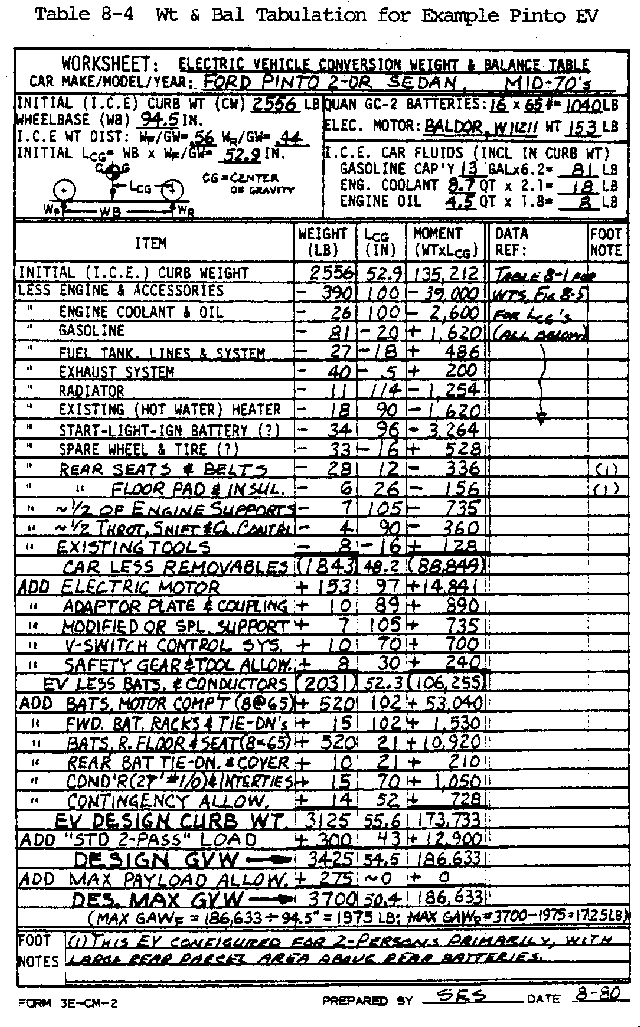
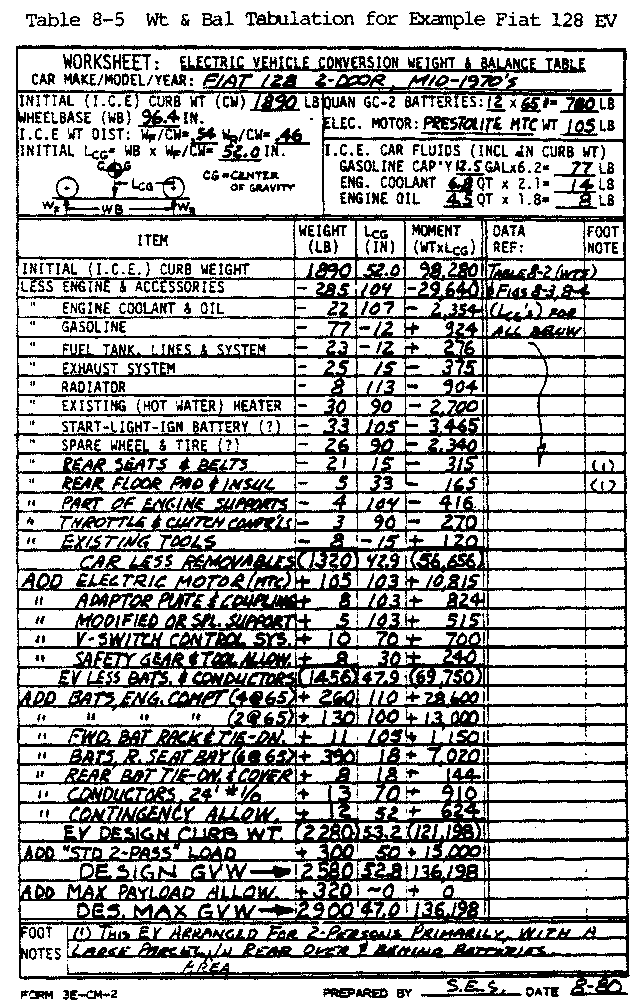
(Follow this link for an Excel balance worksheet, courtesy of David Brandt. WORKSHEET)
For considerations of suspension spring adequacy and satisfactory load-rated tires, it is important to calculate the resulting weight reactions at the front and rear axles, for both the design GVW and design maximum GVW cases. As indicated in the last line of Table 8-4, the front gross axle weight (GAWF) reaction is determined simply by dividing the maximum GVW moment by the wheel base of the car. Knowing this maximum weight supported by the front axle, accordingly, the maximum rear gross axle weight (GAWR) is determined by subtracting the front axle reaction from the GVW. All cars sold in the United States in recent years have a label somewhere on the body that provides its new car maximum GAWF and GAWR. These values usually reflect primarily the rating of the tires initially provided on the car (and are sometimes appreciably lower than the maximum reactions acceptable for the springs, shock absorbers, etc.). Obviously the tires used on the EV conversion should be appropriate for the respective axle weights for the conversion (it is assumed that the tire's maximum load is 1/Z the maximum axle reaction). If one is planning an EV conversion that has appreciably higher axle reactions than the I.C.E. versions in their maximum load condition, it is necessary to consider the amount, and means of providing, auxiliary springing. For some automobiles auxiliary or helper springs (on American car designs often coil springs that clamp on and fit around shock absorbers) are readily available; for others the addition of a spring leaf, auxiliary coil, or heavier coil is more involved and expensive. A few cars, such as the VW Beetle, can accommodate modest changes in axle weight by a readjustment of the torsion spring system.
Prior to calculating the moment changes caused by adding the EV components to the conversion, once the I.C.E. removables are gone, it is necessary to have a plan view layout that locates these components in appropriate positions within the car and at particular distances from the rear axle reference point. Such an EV propulsion layout for the Fiat 128 is shown in Figure 8-4 and for the Pinto in Figure 8-5. Each of these layouts shows the propulsion batteries as evenly divided into two closely grouped packs. Such a grouping is highly desirable, especially with the V-switch control system previously described and assumed herein for performance purposes. In each case it is also seen that the rear battery pack is essentially located where rear passengers would previously have been; while the front battery pack is located in the area of the previous engine and its bulky accessories. Such locations are usually good choices for purposes of F/R weight distribution as well as structural integrity of the car itself. Such a location for the rear battery pack, since the batteries are installed on or very near the lowest floor line, normally provides a considerable, relatively flat area (above the battery pack and extending rearward to the normal baggage compartment) for EV packages or cargo. This arrangement for packages and cargo can also be used (in a rather prone, low-headroom manner) for occasional, short-trip additional passengers. For circumstances requiring conventional rear-passenger seating, the rear battery pack can usually be moved into the previous trunk compartment. This arrangement, however, in addition to the higher GVW, usually results in a considerable increase in rear axle loading, with the requirement of auxiliary rear springing and perhaps higher load-rated tires.
